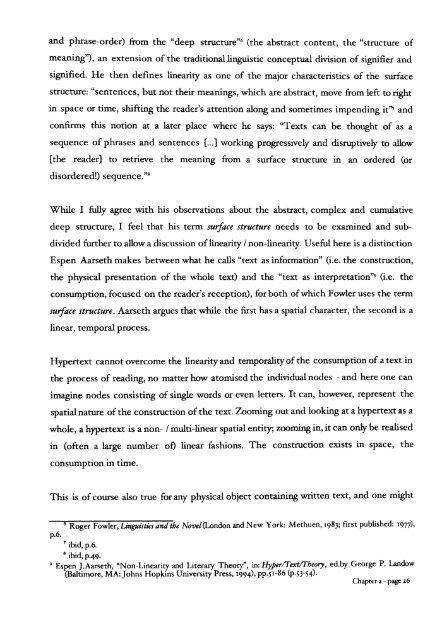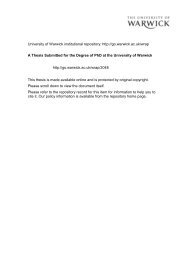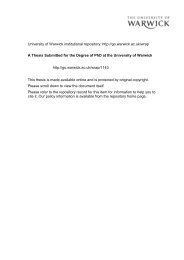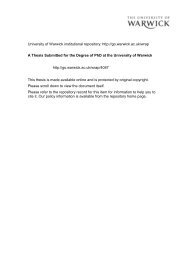From Page to Screen - WRAP: Warwick Research Archive Portal ...
From Page to Screen - WRAP: Warwick Research Archive Portal ...
From Page to Screen - WRAP: Warwick Research Archive Portal ...
You also want an ePaper? Increase the reach of your titles
YUMPU automatically turns print PDFs into web optimized ePapers that Google loves.
and phrase-order) from the "deep structure'" (the abstract content, the "structure of<br />
meaning''), an extension of the traditional linguistic conceptual division of signifier and<br />
signified. He then defines linearity as one of the major characteristics of the surface<br />
structure: "sentences, but not their meanings, which are abstract, move from left <strong>to</strong> right<br />
in space or time, shifting the reader's attention along and sometimes impending it'" and<br />
confirms this notion at a later place where he says: "Texts can be thought of as a<br />
sequence of phrases and sentences {...} working progressively and disruptively <strong>to</strong> allow<br />
{the reader} <strong>to</strong> retrieve the meaning from a surface structure in an ordered (or<br />
disordered!) sequence."<br />
While I fully agree with his observations about the abstract, complex and cumulative<br />
deep structure, I feel that his term surface structure needs <strong>to</strong> be examined and sub<br />
divided further <strong>to</strong> allow a discussion oflinearity / non-linearity. Useful here is a distinction<br />
Espen Aarseth makes between what he calls "text as information" (i.e. the construction,<br />
the physical presentation of the whole text) and the "text as interpretation"? (i.e. the<br />
consumption, focused on the reader's reception), for both ofwhich Fowler uses the term<br />
surface structure. Aarseth argues that while the first has a spatial character, the second is a<br />
linear, temporal process.<br />
Hypertext cannot overcome the linearityand temporalityof the consumption of a text in<br />
the process of reading, no matter how a<strong>to</strong>mised the individual nodes - and here one can<br />
imagine nodes consisting of single words or even letters. It can, however, represent the<br />
spatial nature ofthe construction ofthe text. Zooming out and looking at a hypertext as a<br />
whole, a hypertext is a non- / multi-linear spatial entity; zooming in, it can only be realised<br />
in (often a large number of) linear fashions. The construction exists in space, the<br />
consumption in time.<br />
This is ofcourse also true for any physical object containing written text, and one might<br />
6 Roger Fowler, Linguistics and the Nove/{Londonand New York: Methuen, 1983; first published: 1977),<br />
p.6.<br />
7 ibid, p.6.<br />
8 ibid, P.49.<br />
9 Espen J.Aarseth, "Non-Linearity and Literary Theory", in: Hyper/Text/Theory, ed.by George P. Landow<br />
(Baltimore, MA: Johns Hopkins University Press, 1994), PP·51-86 (P·53-54)·<br />
Chapter 2 - page26





